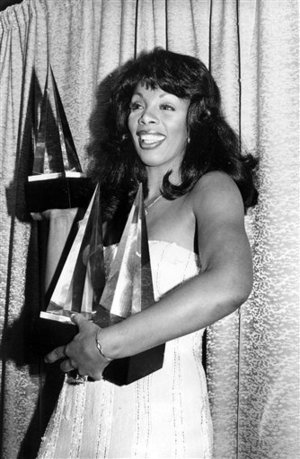skip to main |
skip to sidebar
Donna Summers Album Cover 02

Donna Summer Photos
Electronic music history pre-dates the rock and roll era by decades. Most of us were not even on this planet when it began its often obscure, under-appreciated and misunderstood development. Today, this 'other worldly' body of sound which began close to a century ago, may no longer appear strange and unique as new generations have accepted much of it as mainstream, but it's had a bumpy road and, in finding mass audience acceptance, a slow one.

Donna Summer Photos
Many musicians - the modern proponents of electronic music - developed a passion for analogue synthesizers in the late 1970's and early 1980's with signature songs like Gary Numan's breakthrough, 'Are Friends Electric?'. It was in this era that these devices became smaller, more accessible, more user friendly and more affordable for many of us. In this article I will attempt to trace this history in easily digestible chapters and offer examples of today's best modern proponents.

Donna Summer Photos
To my mind, this was the beginning of a new epoch. To create electronic music, it was no longer necessary to have access to a roomful of technology in a studio or live. Hitherto, this was solely the domain of artists the likes of Kraftwerk, whose arsenal of electronic instruments and custom built gadgetry the rest of us could only have dreamed of, even if we could understand the logistics of their functioning. Having said this, at the time I was growing up in the 60's & 70's, I nevertheless had little knowledge of the complexity of work that had set a standard in previous decades to arrive at this point.
%2B(artwork-02-back%2Bcover)%2B1982.jpeg)
Donna Summer Photos
The history of electronic music owes much to Karlheinz Stockhausen (1928-2007). Stockhausen was a German Avante Garde composer and a pioneering figurehead in electronic music from the 1950's onwards, influencing a movement that would eventually have a powerful impact upon names such as Kraftwerk, Tangerine Dream, Brain Eno, Cabaret Voltaire, Depeche Mode, not to mention the experimental work of the Beatles' and others in the 1960's. His face is seen on the cover of "Sgt. Pepper's Lonely Hearts Club Band", the Beatles' 1967 master Opus. Let's start, however, by traveling a little further back in time.

Donna Summer Photos
Time stood still for this stargazer when I originally discovered that the first documented, exclusively electronic, concerts were not in the 1970's or 1980's but in the 1920's!

Donna Summer Photos
The first purely electronic instrument, the Theremin, which is played without touch, was invented by Russian scientist and cellist, Lev Termen (1896-1993), circa 1919.

Donna Summer Photos
In 1924, the Theremin made its concert debut with the Leningrad Philharmonic. Interest generated by the theremin drew audiences to concerts staged across Europe and Britain. In 1930, the prestigious Carnegie Hall in New York, experienced a performance of classical music using nothing but a series of ten theremins. Watching a number of skilled musicians playing this eerie sounding instrument by waving their hands around its antennae must have been so exhilarating, surreal and alien for a pre-tech audience!

Donna Summer Photos
For those interested, check out the recordings of Theremin virtuoso Clara Rockmore (1911-1998). Lithuanian born Rockmore (Reisenberg) worked with its inventor in New York to perfect the instrument during its early years and became its most acclaimed, brilliant and recognized performer and representative throughout her life.

Donna Summer Photos
In retrospect Clara, was the first celebrated 'star' of genuine electronic music. You are unlikely to find more eerie, yet beautiful performances of classical music on the Theremin. She's definitely a favorite of mine!



%2B(artwork-02-back%2Bcover)%2B1982.jpeg)





